Notes
Police Ride-Along Photography and Natalie Keyssar’s New Turn
Note: this post is an extended version of a panel presentation given at the Image Truth/Story Truth conference on Oct 16th 2015 at the Columbia Journalism School. We offer it now as part of our running series on Twitter and Facebook of the best pictures of 2015.
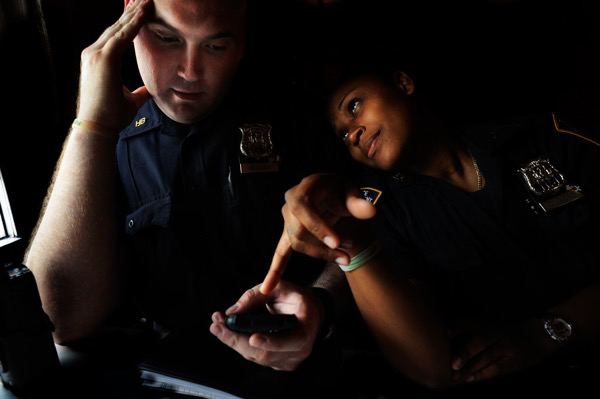 Officers Weadock, left, and Olivero spend their lunch break checking out the precinct gossip on Facebook. Oct. 8, 2009. Antonio Bolfo/Reportage by Getty Images.
Officers Weadock, left, and Olivero spend their lunch break checking out the precinct gossip on Facebook. Oct. 8, 2009. Antonio Bolfo/Reportage by Getty Images.
As concern has escalated in America over police violence and race relations, attention has risen, too, over how photojournalism depicts the issue.
Of all the approaches to the story, one that has been familiar for decades is the police ride-along. Similar to media embedding with the U.S. military during the wars in Afghanistan and Iraq, the practice involves a freelance or wire photographer riding-along with patrol officers, sometimes for days, sometimes for hours, documenting their activity. Going back more than two decades, major media has prominently featured ride-along or police embed photo stories by such photographers as Bruce Davidson, James Nachtwey, Joe Rodriguez (1, 2), Paolo Pellegrin, and others.
Beyond the basic focus on race and law enforcement, however, what are the factors that make these ride-along stories more relevant and more critical to examine now than in the past? As with military embedding, what stands out more and more about these police ride-alongs is how empathetic they can be to the men and women in blue, causing us to overly identify with officers and to “see what they see.”
Of previously published photo projects, a story by Antonio Bolfo is perhaps the most empathetic. That’s understandable given Bolfo’s background. In contrast to photographers who shot the story on assignment, Bolfo transitioned from an art career to join the police force. The intimate images above comes from Bolfo’s photo story published in the NY Times Lens Blog in February 2012, the images taken on the streets of the Bronx while on the job in 2008. Bolfo captures the NYPD in a mostly heroic light, including scenes of officers attempting to rescue a citizen dangling upside down from a building, or a lone female officer traversing the narrow edge of a tenement many stories up.
If the access or the view was not questioned too deeply when photography was circulated via printed newspapers and magazines, the age of Instagram and social media, citizen’s watch, and the impact of the surveillance and the body cam, coupled with concern over racial profiling, police violence and the post 9/11 militarization of local law enforcement has placed a much greater emphasis on the objectivity and the point of view of the “ride along.”
In today’s atmosphere, these stories are notable, as much as anything, for the stereotypes, these stories largely photographed in notoriously dangerous inner city, lower-income African-American or Latino communities. But the stereotyping is not just confined to race or economics. I’m also referring to the consistency of the scenes. The narratives are typified by “peace officers” in a primal battle with black or Latino youth; sometimes gang-identified (by clothing or tattoos) or just coded by style, as evidenced by the caps and the sagging. They are largely captured in the dark or in black-and-white, against housing or stores that are impoverished or decrepit; typically featuring: the chase; suspicious congregating; violent confrontation; and suspects detained and subdued but often still evoking deadliness or menace.
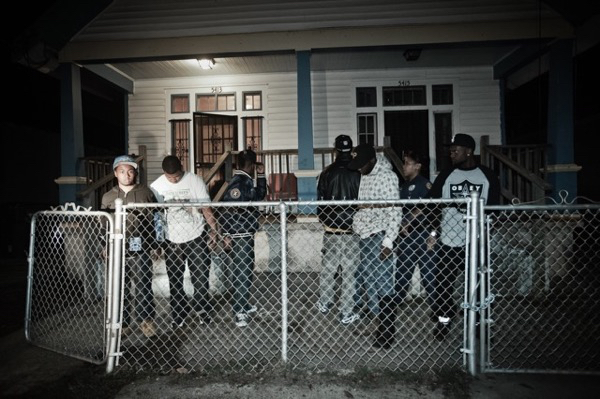 The young men stand in the yard as officers continue their weapons search. Julie Dermansky.
The young men stand in the yard as officers continue their weapons search. Julie Dermansky.
This night photo by Julie Dermansky, for example, was part of her embed photo story in New Orleans published in The Atlantic in 2012. It shows a group of African-American youth behind a chain link fence in what’s identified as a violent neighborhood. A semi-automatic weapon has been found on the porch and one of the youths is taken away for possession.
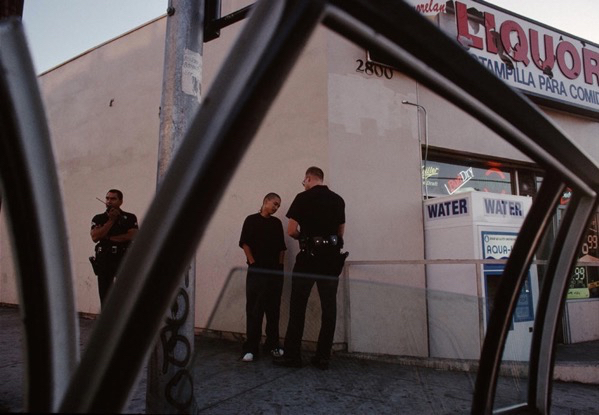 A young man received a ticket for jaywalking. Joseph Rodriguez.
A young man received a ticket for jaywalking. Joseph Rodriguez.
Here we see a photo of a young black male being ticketed for jaywalking in a parking lot outside a shabby liquor store. The photo was taken by Joe Rodriguez while riding with the LAPD in the mid-90’s.
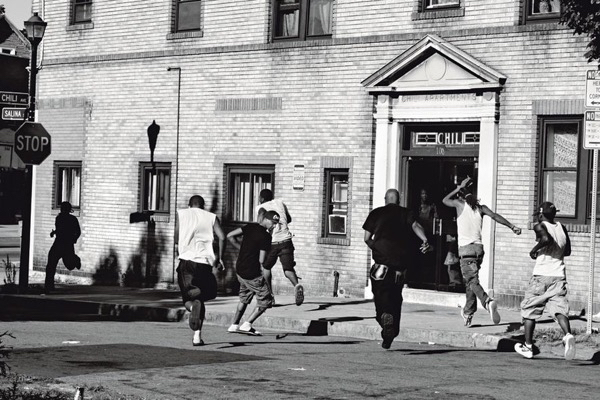 Rochester, New York, USA: Youths run away as a police car approaches a corner known as a drug-dealing spot. The group of deprived neighborhoods known as the ‘Crescent’, around the northern edge of downtown Rochester, New York State, USA, is renowned for its high crime and murder rates. Reasons given for these include a depressed local economy, and the large number of empty houses, prone to becoming locations for drug dealing. Magnum Photos for Postcards from America / Die Zeit Magazine
Rochester, New York, USA: Youths run away as a police car approaches a corner known as a drug-dealing spot. The group of deprived neighborhoods known as the ‘Crescent’, around the northern edge of downtown Rochester, New York State, USA, is renowned for its high crime and murder rates. Reasons given for these include a depressed local economy, and the large number of empty houses, prone to becoming locations for drug dealing. Magnum Photos for Postcards from America / Die Zeit Magazine
This photo by Paolo Pellegrin, taken in the Crescent neighborhood of Rochester, viscerally equates inner city black youth to trouble and sociopathy. When the police show up on a street corner known for drug dealing, the young men “scatter like rats.”
As video and social media has broadcast the fateful experiences of Sandra Bland, Freddy Gray, Walter Scott, Tamir Rice, Eric Garner, and others, those images inevitably emphasize the subjectivity of the view. If these ride-along stories largely offer an identification with the officers, or a “pro-police” bias, however, there is a tendency to stereotype the police, as well.
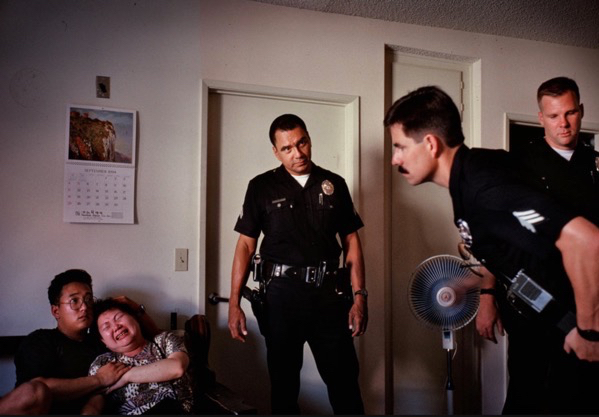 Rampart officers comforted a woman whose husband had just choked to death. Joseph Rodriguez.
Rampart officers comforted a woman whose husband had just choked to death. Joseph Rodriguez.
This photo by Joe Rodriquez, for example, as part of his larger project, East Side Stories, recently featured at the NY Times Lens Blog, concerns a woman in LA who has just lost her husband. Although the caption says these officers were comforting the woman, the body language suggests otherwise.
Ultimately, the real challenge with the ride-along has to do with context and what happens beyond the drama and the polarization. What has been missing in these pictures is the fabric and the more daily dynamics. It’s that challenge that makes the recent photo story by Natalie Keyssar, shot in West Philadelphia for TIME, that outstanding.
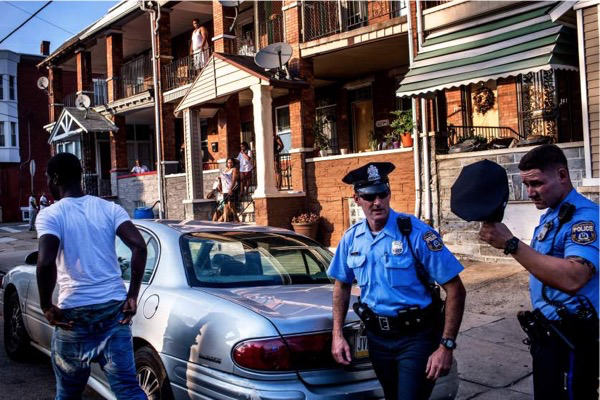 Officers Paul Watson, right, and his partner Officer Richard O’Brien make a traffic stop as neighbors look on. After the police searched his car, the man was released. July 29, 2015. Philadelphia, Pa. Natalie Keyssar for TIME.
Officers Paul Watson, right, and his partner Officer Richard O’Brien make a traffic stop as neighbors look on. After the police searched his car, the man was released. July 29, 2015. Philadelphia, Pa. Natalie Keyssar for TIME.
What is Keyssar doing with her images that has largely been missing before? Above all, they satisfy an increasingly necessary function of the news photo and the still image: they tell stories.
The photos, in fact, are dramatically routine. In contrast to other ride-along stories, the shoe never drops. The police search this young man’s care, then he walks away. And the photo (largely shot in the light of day, I might add) are complex, layered, filled with concurrent action and matrices of meaning.
All in one picture, the mother’s and families have their take on the cops, and they also have their take on the kid. And they have the light, and the more ascendent view. Moreover, the accomplishment of the photo is that the realm of the street and the home are not separated at all.
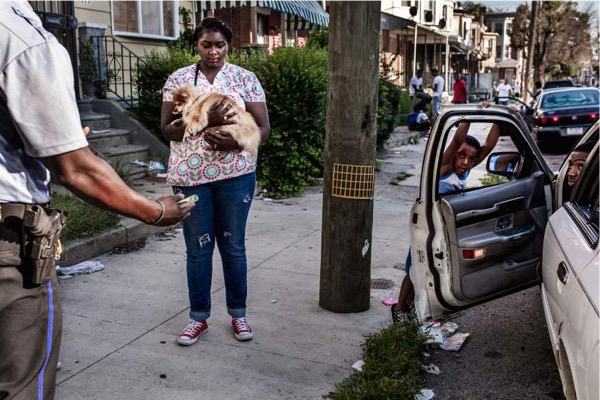 Officers Damon Linder and Edwin Vaughn speak to neighbors, threatening to impound a car which was being driven by a man without a license in West Philadelphia. Ultimately the man was ticketed and the car was released to a licensed driver. July 31, 2015. Philadelphia, Pa. Natalie Keyssar for TIME. July 31st, 2015. Philadelphia.
Officers Damon Linder and Edwin Vaughn speak to neighbors, threatening to impound a car which was being driven by a man without a license in West Philadelphia. Ultimately the man was ticketed and the car was released to a licensed driver. July 31, 2015. Philadelphia, Pa. Natalie Keyssar for TIME. July 31st, 2015. Philadelphia.
The photos are dynamic. Instead of fixed expressions and gestures, you see people looking surmising, summing, calculating. They convey true interaction, observation, learning or imprinting.
You can imagine the kid remembering this moment… while the kids down the street have seen it all… while the girl elects not to engage… while the kid who got pulled over is already beyond it. Incongruity works like glue: keeping the stress in balance is the love for a dog.
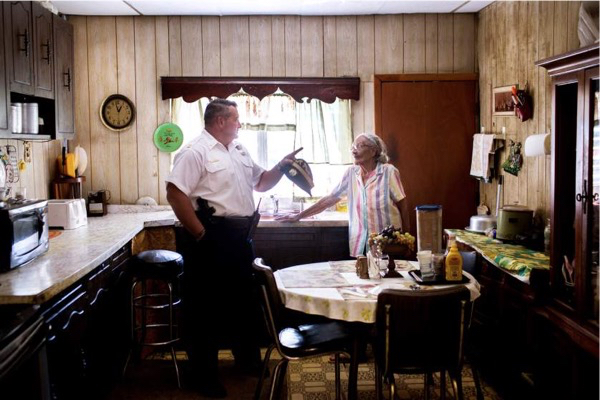 Captain Joe Bologna chats with Louise Robinson in her kitchen after she called him in off the street to look at a problem with overgrowth and vermine in the unkempt garden of an abandoned house behind her home. Robinson has lived in her home down the street from the 19th District station since the ’50s, and says that hers was one of the first black families to move to the neighborhood. July 31, 2015. Philadelphia, Pa. Natalie Keyssar for TIME.
Captain Joe Bologna chats with Louise Robinson in her kitchen after she called him in off the street to look at a problem with overgrowth and vermine in the unkempt garden of an abandoned house behind her home. Robinson has lived in her home down the street from the 19th District station since the ’50s, and says that hers was one of the first black families to move to the neighborhood. July 31, 2015. Philadelphia, Pa. Natalie Keyssar for TIME.
The photos are mutual and relational. Here a captain chats with a woman in her kitchen who called him to discuss routine problems from the abandoned house next door. The caption notes this woman has lived in the precinct since the ’50’s, and was one of its first black residents.
The tension portrayed in these photos does not come from violence or the exercise of power but the day-to-day tension of the police and the community having to deal with each other while negotiating the same space — the community’s space.
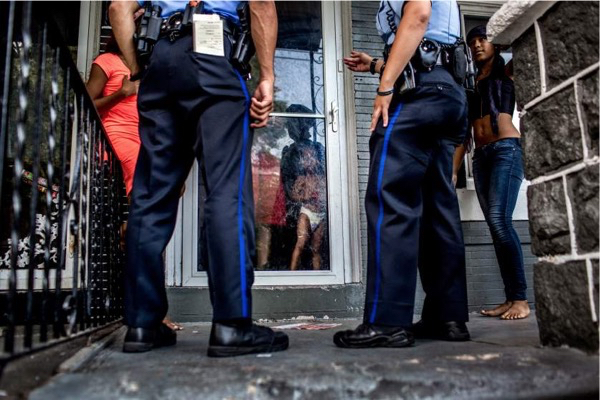 Officers respond to a call regarding a young woman being threatened by an ex boyfriend. After asking a series of questions, the police filed a domestic report. July 29, 2015. Philadelphia, Pa. Natalie Keyssar for TIME.
Officers respond to a call regarding a young woman being threatened by an ex boyfriend. After asking a series of questions, the police filed a domestic report. July 29, 2015. Philadelphia, Pa. Natalie Keyssar for TIME.
The photos are ambiguous in the best way. They are not prejudicial and they are not presenting evidence. They defy moral judgement. And, the roles actually challenge the stereotypes. In this case, shifting from antagonists to advocates, the police respond to a call about a threatening ex boyfriend, and end up filing a report. Notice, by the way, how the point of view is shared. As much as we see the situation from the cops vantage, we also see it, from the ground up, through the eyes of a toddler, and thru the perceiving eyes of the teenage girl in blue.
Like in the last photo, you’ll also notice how Keyssar levels out the power by sometimes framing out some heads.
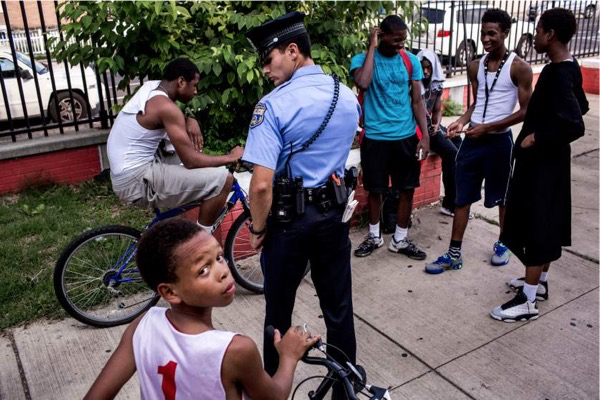 First year officer Jonathan Dedos (a “foot beat”) questions a group of young men after a shooting suspect was described as an African-American wearing white and on a bike, a description which could apply to many young men in the neighborhood. This group, at a local park, was vouched for by a man who works with local youth and the police moved on. July 28, 2015. Philadelphia, Pa. Natalie Keyssar for TIME.
First year officer Jonathan Dedos (a “foot beat”) questions a group of young men after a shooting suspect was described as an African-American wearing white and on a bike, a description which could apply to many young men in the neighborhood. This group, at a local park, was vouched for by a man who works with local youth and the police moved on. July 28, 2015. Philadelphia, Pa. Natalie Keyssar for TIME.
If the photos are stylish, as in the officer’s pose, it’s in the service of more information. Perhaps Keyssar, at least, is hinting at self-reflection, the first-year cop isolating and ostracizing the older kid on the bike because, for the moment, he fit the description of a shooting suspect. Moreover, the photos are generous – They tell us a lot, but they let us navigate. And, keying off the kid in the foreground, they invite us to read the photos for ourselves.
In the light of our polarized society, this is the breadth, the invitation and the reality we can use more of from news photography today.
(Note: updated narrative of Dermansky photo to remove gang allusion.)
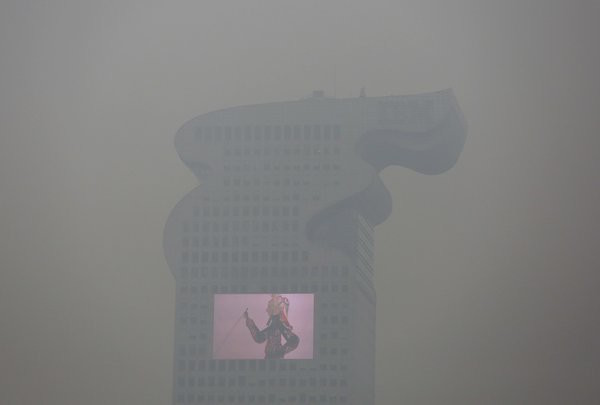
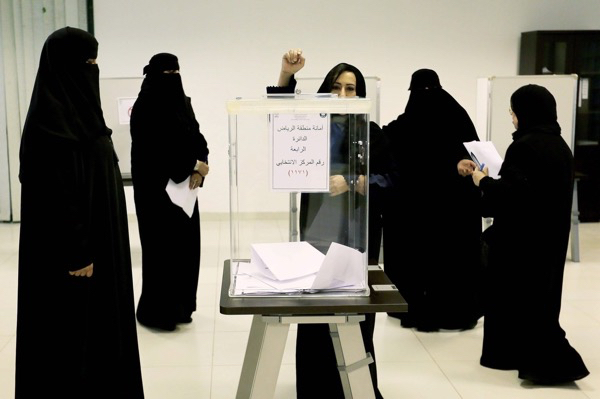
Reactions
Comments Powered by Disqus